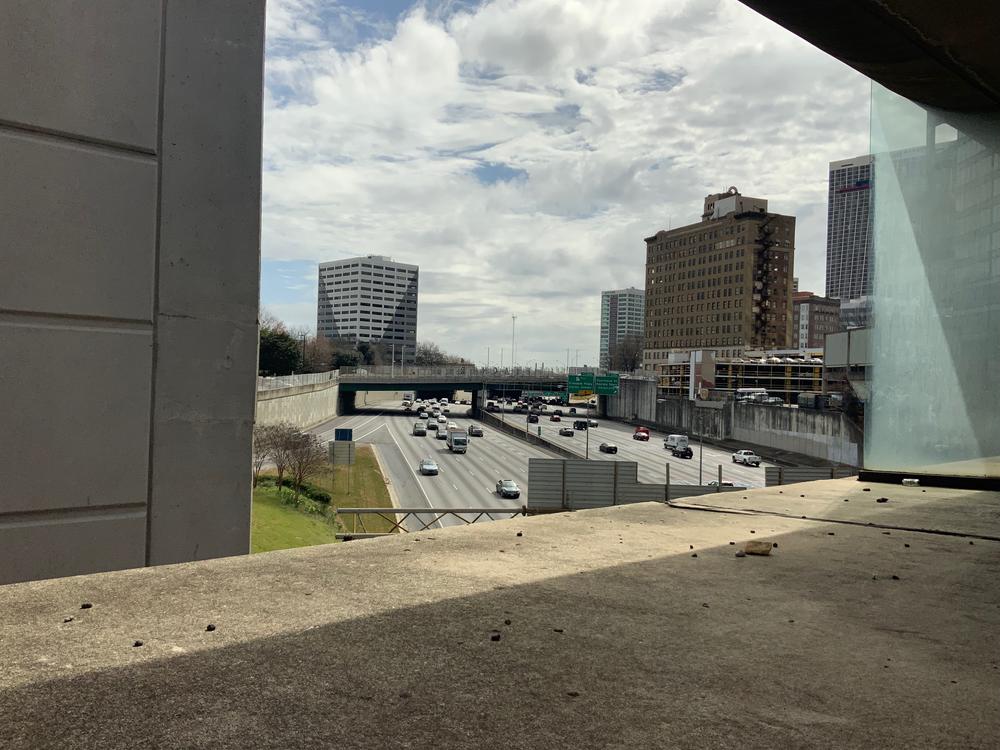Section Branding
Header Content
Proposed Stitch Could Help Reconnect Downtown Atlanta
Primary Content
Central Atlanta Progress has proposed a stitch for downtown Atlanta. It would involve building green space over I-75 and connecting east and west downtown.
GPB's Rickey Bevington and Ross Terrell traveled near the site of the proposed project to discuss what it would look like.
Rickey Bevington: Ross, describe where we're standing.
Ross Terrell: Right now we're standing in the park with Emory Midtown just to our north and the Marriott Marquis just to our south. We're essentially above the highway. I-75 runs right below us a little to our left.
Bevington: And we're standing on the site of the propose “Stitch.”
Terrell: Correct. This is a project by Central Atlanta Progress and it’s designed to “stitch” the city back together. Where we're standing is kind of where I-75 splits the city. To the west you have downtown and to the east of you have the Bank of America building and the hospital. This project will fill in the gaps over the highway by creating green space, so you can walk between each bridge.
Bevington: I think it's hard for modern Atlantans to remember a time when there weren’t huge interstates breaking up our neighborhoods. What will happen and what will it feel like to be here when this proposed Stich is built?
Terrell: Once the stitch is complete, you'll have green space, parks, dog parks, etc. around this entire area but you'll be walking above the freeway. Right now, there's not too much here as far as residential property goes. There are a few hotels, a few office buildings but the project wants to capitalize on the Georgia Power Building which is kind of just to our south and the MARTA Civic Center Station. The plan is to bring this all into one, so you'll be able to traverse from the west side of downtown over to the east side without needing a vehicle.
Bevington: We're not the first city to come up with this idea. Are we modeling this on any other projects?
Terrell: There are quite a few cities that have something like this. In Seattle, you have Freeway Park, but I think this initiative is really modeled after Dallas’ Klyde Warren Park. That park was completed just a few years ago. It's a green space over their major highway. They have activities, you can actually reserve space and you can do all of that over interstate. I think the goal here is once you have this green space, it drives investment and development.
Bevington: This project is characterized by building up. We're just taking airspace and building on top of the highway but will anybody be displaced.
Terrell: Well, much like the Gulch project that we talked about not too long ago, you're taking advantage of space that isn't really being use. These are kind of just open platforms above the highway, so you're not really pushing anyone out. As far as displacing what we call legacy residents that shouldn't really happen with this because no one really lives above the interstate.
Bevington: The idea of walkability and quality urban living seems to be a national trend. It's happening here in Atlanta. Do you see there being real political will to make this happen?
Terrell: Like any major project this is going to require public and private partnership with the public being the city of Atlanta. But there does seem to be a push towards connectivity. We have the Beltline, which is kind of like the cities I-285. It's a sidewalk that you can connect to multiple sides of Atlanta with. And this project will do that in a much more compact way, east to west over the interstate. You should be able to walk from one side of downtown to another and the hope is that drives investment, generates tax dollars and that builds up an area which right now isn't really in use.
Bevington: What is the price tag on this project?
Terrell: As we mentioned this is modeled after some other parks across the country, like Klyde Warren Park in Dallas and the price tag is relatively similar to those. Initial estimates are that this would cost $300 to 400 million.
Bevington: That price tag is really a decade or more in the future. Right. Because this isn't going to happen for a minute.
Terrell: Right. Don't expect to wake up tomorrow morning and have green space above the highway. This project is still about five to 10 years away but we are at the early stages and the conversations are starting to happen about how downtown Atlanta can be stitched back together.
This conversation has been edited for clarity and conciseness.


